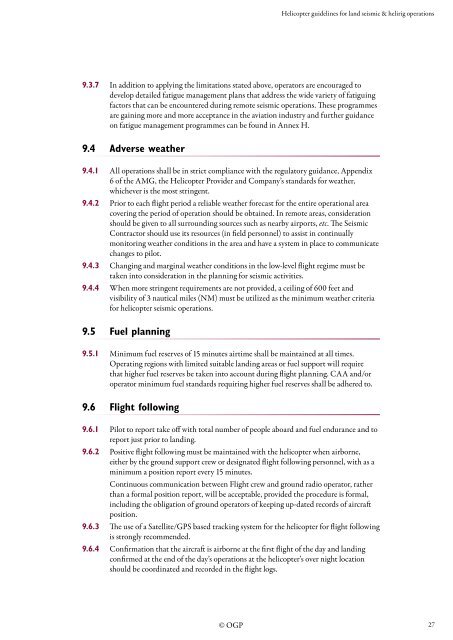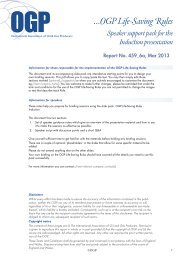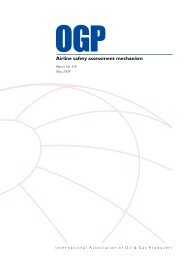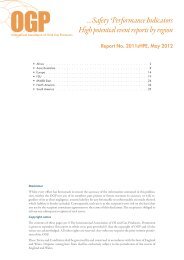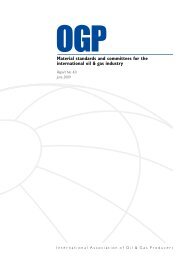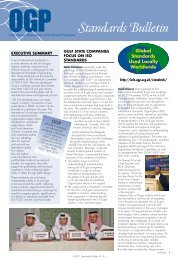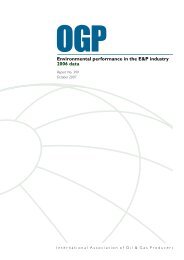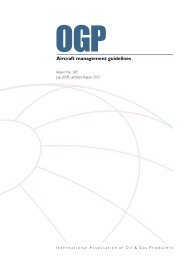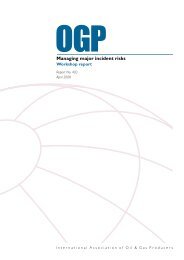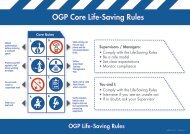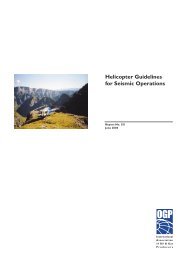Helicopter guidelines for land seismic & helirig operations - OGP
Helicopter guidelines for land seismic & helirig operations - OGP
Helicopter guidelines for land seismic & helirig operations - OGP
You also want an ePaper? Increase the reach of your titles
YUMPU automatically turns print PDFs into web optimized ePapers that Google loves.
<strong>Helicopter</strong> <strong>guidelines</strong> <strong>for</strong> <strong>land</strong> <strong>seismic</strong> & <strong>helirig</strong> <strong>operations</strong><br />
9.3.7 In addition to applying the limitations stated above, operators are encouraged to<br />
develop detailed fatigue management plans that address the wide variety of fatiguing<br />
factors that can be encountered during remote <strong>seismic</strong> <strong>operations</strong>. These programmes<br />
are gaining more and more acceptance in the aviation industry and further guidance<br />
on fatigue management programmes can be found in Annex H.<br />
9.4 Adverse weather<br />
9.4.1 All <strong>operations</strong> shall be in strict compliance with the regulatory guidance, Appendix<br />
6 of the AMG, the <strong>Helicopter</strong> Provider and Company’s standards <strong>for</strong> weather,<br />
whichever is the most stringent.<br />
9.4.2 Prior to each flight period a reliable weather <strong>for</strong>ecast <strong>for</strong> the entire operational area<br />
covering the period of operation should be obtained. In remote areas, consideration<br />
should be given to all surrounding sources such as nearby airports, etc. The Seismic<br />
Contractor should use its resources (in field personnel) to assist in continually<br />
monitoring weather conditions in the area and have a system in place to communicate<br />
changes to pilot.<br />
9.4.3 Changing and marginal weather conditions in the low-level flight regime must be<br />
taken into consideration in the planning <strong>for</strong> <strong>seismic</strong> activities.<br />
9.4.4 When more stringent requirements are not provided, a ceiling of 600 feet and<br />
visibility of 3 nautical miles (NM) must be utilized as the minimum weather criteria<br />
<strong>for</strong> helicopter <strong>seismic</strong> <strong>operations</strong>.<br />
9.5 Fuel planning<br />
9.5.1 Minimum fuel reserves of 15 minutes airtime shall be maintained at all times.<br />
Operating regions with limited suitable <strong>land</strong>ing areas or fuel support will require<br />
that higher fuel reserves be taken into account during flight planning. CAA and/or<br />
operator minimum fuel standards requiring higher fuel reserves shall be adhered to.<br />
9.6 Flight following<br />
9.6.1 Pilot to report take off with total number of people aboard and fuel endurance and to<br />
report just prior to <strong>land</strong>ing.<br />
9.6.2 Positive flight following must be maintained with the helicopter when airborne,<br />
either by the ground support crew or designated flight following personnel, with as a<br />
minimum a position report every 15 minutes.<br />
Continuous communication between Flight crew and ground radio operator, rather<br />
than a <strong>for</strong>mal position report, will be acceptable, provided the procedure is <strong>for</strong>mal,<br />
including the obligation of ground operators of keeping up-dated records of aircraft<br />
position.<br />
9.6.3 The use of a Satellite/GPS based tracking system <strong>for</strong> the helicopter <strong>for</strong> flight following<br />
is strongly recommended.<br />
9.6.4 Confirmation that the aircraft is airborne at the first flight of the day and <strong>land</strong>ing<br />
confirmed at the end of the day’s <strong>operations</strong> at the helicopter’s over night location<br />
should be coordinated and recorded in the flight logs.<br />
© <strong>OGP</strong><br />
27


